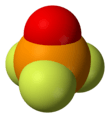Phosphoryl fluoride
| |||
| Names | |||
|---|---|---|---|
| IUPAC names
Phosphoryl trifluoride Phosphorus trifluoride oxide | |||
| Other names
Phosphorus oxyfluoride Phosphoric trifluoride | |||
| Identifiers | |||
3D model (JSmol) |
|||
| ChemSpider | |||
| ECHA InfoCard | 100.033.419 | ||
| EC Number | 236-776-4 | ||
PubChem CID |
|||
| UNII | |||
| |||
| |||
| Properties | |||
| POF3 | |||
| Molar mass | 103.9684 g/mol | ||
| Appearance | Clear, colourless gas | ||
| Boiling point | −39.7 °C (−39.5 °F; 233.5 K) | ||
| Reacts | |||
| Solubility | Reacts with alcohol and acid soluble in ether and hydrocarbons | ||
| Structure | |||
| tetrahedral | |||
| D | |||
| Hazards | |||
| Main hazards | Poison, corrosive, can form HF on contact with H2O | ||
| Safety data sheet | ICSC 0190 | ||
EU classification (DSD) (outdated) |
|||
| R-phrases (outdated) | R14, R34, R36/37/38[1] | ||
| S-phrases (outdated) | (S1/2), S7/9, S26, S36/37/39, S45 | ||
| NFPA 704 | |||
| Related compounds | |||
Related compounds |
Thiophosphoryl fluoride Phosphoryl chloride Phosphorus oxybromide Phosphorus trifluoride Phosphorus pentafluoride | ||
Except where otherwise noted, data are given for materials in their standard state (at 25 °C [77 °F], 100 kPa). | |||
| Infobox references | |||
Phosphoryl fluoride (commonly called phosphorus oxyfluoride) is a compound with the chemical formula POF3. It is a colorless gas that hydrolyzes rapidly.
Synthesis and reactions
Phosphorus oxyfluoride is prepared by partial hydrolysis of phosphorus pentafluoride.
Phosphorus oxyfluoride is the progenitor of the simple fluorophosphoric acids by hydrolysis. The sequence starts with difluorophosphoric acid:
- POF3 + H2O → HPO2F2 + HF
The next steps give monofluorophosphoric acid and phosphoric acid:
- HPO2F2 + H2O → H2PO3F + HF
- HPO3F + H2O → H3PO4 + HF
Phosphoryl fluoride combines with dimethylamine to produce dimethylaminophosphoryldifluoride (CH3)2NPOF2 and difluorophosphate and hexafluorophosphate ions.[2]
References
- ↑ http://www.chemicalbook.com/ProductChemicalPropertiesCB3329830_EN.htm
- ↑ Cavell, R. G. (1968). "Chemistry of phosphorus fluorides. Part III. The reaction of thiophosphoryl-fluoride with dimethylamine and some properties of the dimethylaminothio- phosphoryl fluorides". Canadian Journal of Chemistry. 46 (4): 613. doi:10.1139/v68-100. Retrieved 2 Feb 2012.
| Wikimedia Commons has media related to Phosphoryl fluoride. |
This article is issued from
Wikipedia.
The text is licensed under Creative Commons - Attribution - Sharealike.
Additional terms may apply for the media files.


